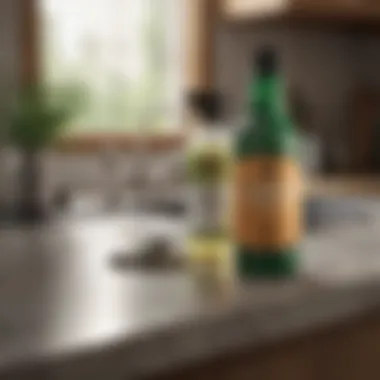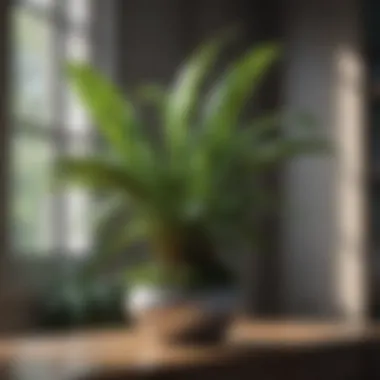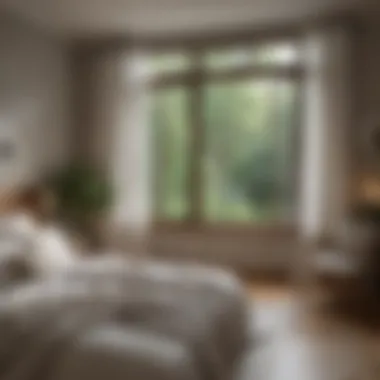Eliminating Old Smell From Your Home: A Comprehensive Guide


Intro
Unpleasant odors in a home can impact overall comfort and well-being. Many homeowners might notice that their living spaces start to accumulate smells over time. These odors can originate from various sources including, but not limited to, aging furniture, stagnant air, or even certain cleaning products. Addressing these olfactory issues requires a multifaceted approach, involving both immediate cleaning procedures and long-term strategies to maintain air quality.
In this comprehensive guide, we will discuss practical solutions to effectively eliminate old smells from your home. We will highlight key sources of these odors, recommend cleaning methods, and suggest preventative measures to promote a fresher atmosphere. Moreover, maintaining air quality will be examined for its crucial role in enhancing home aesthetics and occupant satisfaction.
Design Inspiration
While addressing odors in your home, it is also valuable to consider how design elements can influence scents and overall atmosphere. Current interior design trends often embrace airiness and openness, inviting more light and air into the space. This can help mitigate stale odors, presenting a more inviting environment.
Current Interior Design Trends
In recent years, trends have shifted towards minimalistic designs, which favor lighter colors and natural materials. These choices often lead to increased ventilation and less clutter, which may capture and retain unwelcome smells. Incorporating plants can further enhance air quality. Some suitable options include:
- Spider Plant: Known for purifying the air.
- Snake Plant: Can survive in low light and releases oxygen at night.
- Peace Lily: Helps reduce indoor humidity while absorbing toxins.
Each of these can also add a touch of green to your home, enhancing aesthetic appeal while combating unpleasant smells.
Color Palettes and Their Effects
The choice of color in home interiors has significant psychological impacts, often dictating how fresh a room feels. Soft, neutral tones like light greens or blues can create a calming atmosphere. They also complement natural light better, which may help further reduce odors by making spaces appear more open.
"A well-designed space not only looks appealing but also contributes to a healthier living environment."
Cleaning Methods
When tackling odors, it becomes essential to employ effective cleaning methods. Addresses sources of smells is critical.
- Identify the Source: Check fabrics, carpets, and even walls for potential culprits.
- Air Out Your Home: Opening windows can replace stale air with fresher outside air.
- Use Baking Soda: This substance is renowned for absorbing odors. Sprinkle it on carpets and let it sit before vacuuming.
Paulownia wood or cedar wood can be beneficial because they naturally repel insects and absorb excess moisture, helping to combat odors.
Preventative Measures
Ultimately, the best way to keep smells at bay involves consistent maintenance. Consider these tips:
- Regularly change air filters in HVAC systems to ensure they are efficiently trapping dust and odors.
- Schedule seasonal deep cleanings to maintain freshness.
- Invest in a dehumidifier to control moisture levels in the home, which can attract unwanted smells.
By synthesizing the information from cleaning methods to seasonal upkeep, homeowners can create a more inviting and fresh living space. This understanding of air quality's impact aligns with the overarching aim of achieving a comfortable, aesthetically pleasing home.
In this exploration of eliminating unpleasant odors, we believe there is more than just cleaning involved; it's about crafting an inviting space conducive to relaxation and enjoyment.
Understanding the Sources of Old Smells
Understanding the sources of old smells is a fundamental step to effectively eliminate these unpleasant odors from your home. Without pinpointing the root causes, efforts to freshen the air may prove futile. Each source contributes uniquely to the overall aroma of a space, and recognizing them can aid in formulating targeted strategies for elimination.
When homeowners identify the origins of these smells, they can take further steps to address them. For example, simply masking an odor with air fresheners often does not resolve the underlying problems. Such approaches can lead to a cycle of temporary relief followed by persistent issues. Hence, acknowledging what leads to odors offers significant benefits.
By focusing on specific elements such as moisture, organic decay, or the materials in the home, one can effectively manage the environment. Regular assessment and maintenance of key areas can prevent foul smells from circulating, helping to maintain a welcoming atmosphere. This section will discuss common contributors to old smells, the effects of moisture and humidity, the role of decaying organic matter, and influence of fabrics and upholstery.
Identifying Common Odor Contributors
Common sources of bad smells in homes are often overlooked. Pets, food remnants, and improper waste disposal are just a few of the notable offenders. Old food in the fridge or pantry can create strong odors if left unchecked. Additionally, garbage disposals and trash cans can release unpleasant scents if not cleaned regularly.
More subtle sources include dusty vents and filters, which can carry musty smells throughout the home. Even forgotten items, like clothes in closets, can accumulate odors over time. Being vigilant about identifying these contributors can save time and frustration in the long run.


Effects of Moisture and Humidity
Moisture and humidity are key factors in the development of mold and mildew, which are notorious for causing musty smells. High levels of humidity can create an environment conducive to these types of growth. Bathrooms, kitchens, and basements often bear the brunt of these issues. Proper ventilation is therefore essential in these areas, especially after cooking or showering.
Regular monitoring of humidity levels can provide insights into potential issues. Using tools like hygrometers can help in taking control of the environment. Keeping humidity below fifty percent can greatly reduce odors linked to moisture.
The Role of Decaying Organic Matter
Decaying organic matter is another significant source of unpleasant odors. This category includes things like food debris, dead leaves, and even pet waste. When organic material breaks down, it emits gases that can linger if not addressed. Compost areas, if improperly maintained, can also produce strong odors that might spread throughout a garden or home.
Thus, regular cleaning and proper waste disposal practices are crucial. Homeowners should inspect their spaces routinely to find decaying matter and eliminate it before it affects air quality.
Influence of Fabrics and Upholstery
Fabrics and upholstery can absorb odors over time. Sofas, carpets, and curtains are prone to retaining smells from cooking, pets, and even smoke. While they play a vital role in home aesthetics, they also require regular maintenance. Simply vacuuming is not always enough. Deep cleaning these items can significantly improve the air quality.
Using appropriate cleaning products tailored for specific materials can yield better results. Always test a small area before applying any new product broadly. Taking care of fabrics not only enhances comfort but also elevates the overall ambiance of the home.
Initial Steps for Odor Assessment
Addressing the presence of old smells in a home requires methodical approaches. The first step in this process is to conduct an effective assessment of the odors. Identifying the culprit behind unpleasant scents is not only essential but also beneficial for implementing the right cleaning strategies. Without a clear understanding of the sources, any efforts to eliminate the odors may yield insufficient results. This section will explore two core elements: conducting a systematic smell test and mapping areas of concern.
Conducting a Systematic Smell Test
A systematic smell test can be seen as the initial investigative step. It helps to pinpoint the areas where the odors are strongest. By being methodical, homeowners can systematically assess each room. Here’s how to perform this test effectively:
- Start Small: Begin in one room at a time. This focused approach prevents being overwhelmed.
- Use Your Nose: Move around the space slowly and take deep breaths. Pay attention to any changes in smell as you move.
- Note Strong Areas: Use a notebook to jot down which areas have stronger odors. Focus on spots like corners, designated storage areas, and behind large furniture.
- Check Fabrics: Don’t forget to assess upholstery, curtains, and carpets. These can absorb smells over time.
Performing this test systematically enables the identification of problem areas quickly, leading to more effective solutions that target specific sources of old smells.
Mapping Areas of Concern
Mapping areas of concern builds upon the findings of the smell test. It turns observations into actionable data. The benefits of this mapping process are significant, providing a clear view of where to focus cleaning efforts. Here’s how to create this map:
- Visual Inspection: After completing the smell test, take a look at the identified areas. What does the visual condition look like?
- Record Findings: Create a list or a simple sketch of the home layout that includes locations of concern. For instance, mark areas near:
- Prioritize: Identify which areas require immediate attention versus those that can be addressed later. Focusing on the high-priority areas like the kitchen or areas with heavy traffic can provide quicker relief from odors.
- Kitchen: Check for remnants that may cause odors.
- Basement: Often a source of musty smells.
- Bathroom: Humidity can create odors that linger.
By conducting a systematic smell test and mapping areas of concern, homeowners set the stage for an effective odor elimination strategy. This process helps streamline the cleaning techniques that follow, ensuring that no area is overlooked during subsequent assessments and cleansing efforts.
Identifying sources correctly greatly enhances the effectiveness of the cleaner strategies.
Cleaning Techniques to Remove Old Smells
Cleaning techniques play a crucial role in eliminating old smells from your home. Over time, various odors can infiltrate living spaces, transforming a once pleasant environment into something uninviting. Addressing these smells involves not only identifying their sources but also employing effective cleaning methods that target the problem areas in your home.
These techniques enhance overall air quality and improve the aesthetic appeal of a room. Furthermore, a thorough cleaning can help prevent the return of these unpleasant odors. Utilizing appropriate methods ensures that each surface is treated according to its specific needs and can lead to long-lasting freshness.
Deep Cleaning Carpets and Rugs
Carpets and rugs often harbor trapped odors, making them a primary target in the quest to eliminate old smells. Dirt, dust, and pet dander get embedded in the fibers, contributing to a stale environment. Regular vacuuming is essential, but it may not be sufficient for deep-seated odors.
- Steam Cleaning: This method uses hot water to penetrate the carpet fibers, effectively loosening dirt and odors. Steam cleaning not only cleans but also sanitizes, killing bacteria that may cause smells. Most homeowners can rent a steam cleaner or hire a professional service to do the job.
- Baking Soda Treatment: Sprinkling baking soda over carpets and letting it sit for a few hours before vacuuming can absorb odors. It is a simple solution that can make a significant difference.
- Specialized Cleaners: There are numerous products available specifically designed to tackle pet odors or mildew. It is important to choose a cleaner that is compatible with your carpet type to avoid damage.
Upholstery Cleaning Solutions


Upholstered furniture can also retain unpleasant smells from spills and everyday use. The cleaning of upholstery requires different methods depending on the material.
- Check the Care Tags: Most upholstered pieces come with care instructions. These insights are invaluable for determining the right cleaning approach.
- Vacuuming: Just like carpets, upholstery should be regularly vacuumed to remove dust and dirt. Use upholstery attachments to reach all nooks and crannies.
- Spot Cleaning: For stains, prompt spot cleaning with a mixture of mild detergent and water is effective. Test a small, inconspicuous area first to ensure there is no discoloration.
- Professional Cleaning: In cases of extreme soiling or persistent smells, professional cleaning may be necessary. Experts have access to high-grade tools and solutions that can restore upholstery without harming it.
Strategies for Freshening Walls
Walls can absorb odors over time, especially in areas like kitchens or bathrooms. Here are some strategies to manage wall odors effectively:
- Wash with Soap and Water: For general cleanup, a solution of mild soap and warm water will suffice. Cloths or sponges can be used to gently scrub the surfaces.
- Vinegar Solution: A mixture of equal parts vinegar and water can also be used as a natural deodorizer. This solution effectively neutralizes odors and is safe for most painted walls.
- Painting Over: If odors are deeply embedded and persistent, a fresh coat of paint may be necessary. Using a high-quality primer designed to block odors can further enhance the effect.
Dealing with Hard Surfaces
Hard surfaces, such as floors, countertops, and tiles, also contribute to old smells. Cleaning these areas regularly is essential to maintain a fresh home.
- Mopping and Sweeping: Regularly sweeping and mopping hard floors helps remove dirt that can lead to unpleasant odors. Consider using a cleaning solution that contains antimicrobial properties for extra hygiene.
- Surface Disinfectants: For kitchens and bathrooms, using surface disinfectants removes bacteria that can lead to bad smells. Ensure to follow the manufacturer's instructions for safe application.
- Grout Cleaning: In tiled areas, grout can absorb odors. Use a mixture of baking soda and water to scrub the grout lines, or consider a specialized grout cleaner.
In summary, addressing odors in carpets, upholstery, walls, and hard surfaces is vital for maintaining a fresh home. By employing these cleaning techniques, you tackle both visible stains and invisible odors effectively.
Natural Remedies for Odor Control
Natural remedies offer a practical approach to mitigating unpleasant odors within the home. Their appeal lies not only in their effectiveness but also in their eco-friendliness. Using common household ingredients can help to control odors without the need for harsh chemicals, making them a preferred choice for many homeowners. By understanding the effectiveness of these solutions, one can create a more pleasant living space while also being mindful of health and the environment.
Utilizing Vinegar and Baking Soda
Vinegar is widely recognized for its remarkable ability to neutralize odors. It works by breaking down the compounds that cause bad smells. When combined with baking soda, the effectiveness amplifies. Baking soda absorbs odors and can be used in various forms. Here are some practical uses for both:
- Deodorizing carpets: Mix a solution of equal parts vinegar and water in a spray bottle. Lightly mist the carpet. After it dries, sprinkle baking soda over the area. Wait about 15 minutes before vacuuming to remove absorbed odors.
- Cleaning appliances: Use vinegar to cleanse your refrigerator or microwave. Simply wipe surfaces with a solution of vinegar and water, and let it air dry.
- Scented baking soda: Adding a few drops of your favorite essential oil to baking soda can enhance its application as a deodorizer. Place this mixture in small bowls around the house for consistent freshness.
"Both vinegar and baking soda work effectively to tackle odors at their source, creating a fresher environment."
Essential Oils as Natural Fresheners
Essential oils provide a pleasant aroma while also offering antibacterial properties. Their versatility allows you to customize scents according to your preference. Some commonly used oils include:
- Lavender: Known for its calming effects, lavender can also ward off unwanted odors. Adding drops of lavender oil to cleaning solutions or diffusers can help freshen spaces naturally.
- Tea Tree Oil: This oil is effective in neutralizing mold and mildew odors. It can be mixed with water in a spray bottle for use in kitchens or bathrooms.
- Citrus Oils: Oils such as lemon or orange create an uplifting scent. They can be used to freshen up linens or add fragrance to vinegar solutions for cleaning.
To use essential oils effectively:
- Add them to diffusers for a lingering scent throughout the home.
- Combine with water in a spray bottle, shaking well before application on upholstery or linens.
Investing time in these natural remedies can yield lasting benefits for odor management. By integrating vinegar, baking soda, and essential oils into your cleaning routine, a fresher home environment can easily be achieved.
Air Quality Management
Effective air quality management is critical in creating a pleasant living environment. Many homeowners may overlook how air quality influences not only the overall smell of a home but also the health and well-being of its inhabitants. Poor air quality can lead to various issues, including lingering odors, allergens, and an uncomfortable atmosphere. Understanding the specifics of air quality and implementing effective management strategies provides numerous benefits, ranging from improved comfort to better health outcomes.
Importance of Ventilation
Ventilation is a cornerstone of air quality management. It allows fresh air to circulate throughout the home, reducing the concentration of stale air and unpleasant odors. When equipped with windows or HVAC systems that promote airflow, a space can transform significantly. Proper ventilation helps in:
- Removing Odors: It diminishes the potency of old smells by replacing stale air with fresh outdoor air.
- Reducing Humidity: High humidity levels can lead to mold and mildew, further contributing to musty smells.
- Enhancing Overall Comfort: Proper airflow makes a home feel more inviting and less oppressive.
Regularly opening windows or using exhaust fans during cooking and bathing can facilitate a continuous exchange of air. It is crucial to assess how often a space is ventilated, especially in rooms most prone to odor, such as the kitchen and bathroom.
Air Purifiers and Their Efficacy


Air purifiers are another vital tool in managing indoor air quality. They serve to filter out allergens, pollutants, and odors, making the air cleaner and more enjoyable to breathe. Different types of air purifiers utilize various technologies, including HEPA filters and activated carbon.
When selecting an air purifier, consider the following:
- Filter Type: HEPA filters effectively trap small particles, including dust and pet dander. Activated carbon filters excel at removing odors and gases.
- Size and Capacity: Ensure the air purifier is rated for the room size. A unit designed for a larger space will be less effective in a smaller room.
- Maintenance: Regular filter changes are essential for optimal performance.
Using air purifiers, especially in conjunction with proper ventilation, can significantly enhance the freshness of your home.
Humidity Control Solutions
Humidity control is crucial for maintaining air quality and preventing unpleasant odors. High humidity creates an environment conducive to the growth of mold and mildew. Managing humidity levels contributes to better air quality, which directly correlates with the elimination of old smells.
Implement the following strategies to control humidity:
- Use Dehumidifiers: These devices help in maintaining a balanced moisture level, particularly in damp areas like basements or laundry rooms.
- Monitor Indoor Plants: While they improve air quality, some plants can increase humidity. Balance is key.
- Routine Checks: Regularly inspect areas prone to moisture, such as bathrooms and kitchens. Address leaks or water buildup promptly.
Ultimately, effective air quality management not only enhances the olfactory experience in your home but also contributes to overall comfort and health. Consider these factors seriously, and address them as part of your strategy in eliminating old smells.
Preventative Measures Against Old Smells
Preventing old smells in your home goes beyond simple cleaning. It involves understanding and implementing effective strategies that not only address current odor issues but also stop future problems from arising. Old smells are often a product of neglecting specific areas within the home. By taking proactive steps, you ensure a more pleasant and inviting environment for all.
Routine practices play a significant role in maintaining a fresh atmosphere. Regularly cleaning surfaces, vacuuming carpets, and ensuring proper ventilation can greatly reduce the risk of odor accumulation. Implementing these habits may seem mundane, but they can have lasting effects on air quality and overall comfort at home.
Regular Maintenance Practices
Consistent maintenance is crucial when aiming to eliminate old smells. Here are some effective practices homeowners should consider:
- Dusting and Vacuuming: Regularly dusting surfaces and vacuuming carpets helps eliminate dust and allergens that contribute to unpleasant odors.
- Washing Fabrics: Curtains, upholstery, and even throw pillows can trap odors. Washing them periodically keeps your living spaces fresh.
- Inspecting Plumbing: Sometimes, persistent smells come from plumbing issues. Regularly checking for leaks or standing water around sinks, toilets, and drains can help identify problems early.
- Air Filter Replacement: Changing air filters in HVAC systems on a set schedule ensures that you are preventing odor build-up and maintaining air quality.
Taking these measures seriously is essential. They not only improve air quality but also prolong the life of your home’s features.
Strategizing Home Layout for Freshness
How you arrange your home can influence airflow and odorous material placement. Thoughtful layout can minimize odor hotspots:
- Use Open Spaces: Keep high-traffic areas clear. Clear pathways improve circulation and allow fresh air flow, while clutters can trap smells.
- Separate Areas: Assign specific areas for certain activities, like dedicating a section for pet-related items. This separation can confine unpleasant odors to specific locations.
- Indoor Plants: Using plants strategically can enhance air quality. Plants like snake plants and peace lilies help filter air naturally and mitigate smells.
Good positioning of furniture and active ventilation can make a significant impact in reducing lingering odors in your home.
Ending and Long-term Strategies
Understanding how to eliminate old smells is not just about immediate solutions; it also involves creating sustainable practices that maintain freshness in your home over time. This section emphasizes the importance of assessing effective long-term strategies to ensure a continuous pleasant environment.
Evaluating Results
After implementing the various cleaning methods and odor control measures discussed earlier, it is crucial to evaluate the results. First, reflect on the specific areas where you felt the most improvement. Consider the methods that worked best and why. Keeping a log of changes can help identify trends or ongoing issues.
When assessing effectiveness, examine certain factors:
- Duration of Freshness: How long do the efforts last before smells return?
- Areas of Focus: Which spaces benefitted most from your actions? Living rooms, kitchens, or bedrooms?
- Personal Satisfaction: Are you pleased with the outcome?
This assessment not only informs you of your degree of success but also lays groundwork for future strategies. If you find persistent odors, reassess your cleaning tools or methods.
Importance of Consistent Efforts
Keeping your home smelling fresh requires ongoing diligence. It is easy for old smells to creep back in if one falls back into neglectful habits. Regular maintenance is essential. Incorporating consistent practices helps safeguard against the re-emergence of unpleasant odors.
Benefits of maintaining consistent efforts include:
- Long-lasting Results: Regular cleaning and care help sustain a fresher environment.
- Prevention of Future Odors: By consistently addressing potential sources of smells, you can avoid larger problems down the line.
- Air Quality Improvement: Continuous efforts improve indoor air quality, benefiting your health and comfort.
In summary, assessing results and maintaining consistency constitute the backbone of effective odor management. It is not a one-time effort, but a comprehensive lifestyle choice to keep your living space inviting and pleasant.















